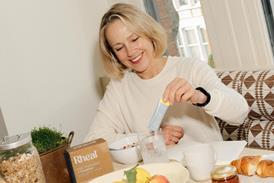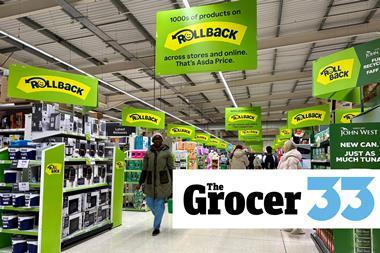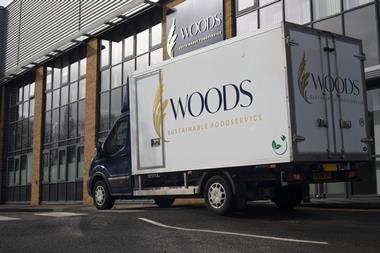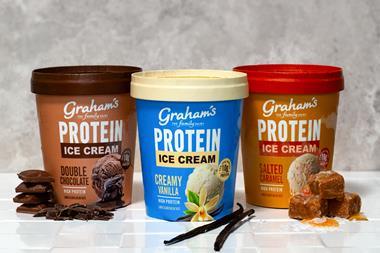Liz Hamson visits Wakefield to see how Asda has revolutionised warehouse management efficiency with a voice-based system
Despite working in temperatures of -25C, colleagues in the freezer at Asda’s chilled distribution centre in Wakefield never wore gloves. It wasn’t because they were hard nuts - though it takes a certain type of person to work in such an inhospitable environment - it was because they couldn’t pick labels with gloves on.
Today, there are no labels thanks to the introduction of Vocollect voice-picking technology. So gloves are back in. They are one of the more prosaic benefits of Asda’s new warehouse management system adapted from Wal-Mart’s global distribution system, piloted at the chilled and ambient depots in Wakefield over the past year and now being rolled out across Asda’s distribution network.
The Grocer visited the centre to speak to Nick Morgan, operations manager and Caroline Fenwick, central systems manager for distribution.
When Asda became part of Wal-Mart, the first priority was to convert the warehouse management system. Once the stores had been brought into line, attention turned to the depots and overhauling processes that were15 to 20 years old and paper-based. Morgan says bluntly: “We’ve now got 20 or more depots in the network and they weren’t handling the amount of work it had.”
Take the CDC. It is the biggest chilled depot in the network, handling 1.3 million cases a week on average and servicing a network of 45 stores. The volume of traffic has increased enormously year-on-year, says Morgan. “Last year it was 50 stores, but we’ve seen throughput increase by 10% year-on-year.”
Put simply, a paper-based system wasn’t up to the job. Asda is overhauling the system in four areas: receiving, picking, pick slot replenishment and invoicing. By the end of the month,voice stock-picking and radio frequency scanning to receive and put away stock will have been introduced to 14 depots. Last week, the depot started piloting radio frequency pick slot replenishment and voice-pick by line, with roll-out to the rest of the estate expected to begin in April. And in June, the invoicing pilot and roll-out will begin.
Although the system is not yet fully operational, the benefits are already apparent, says Fenwick: “It speeds up the whole process. The emphasis is very much on accuracy, which is the key to availability. There have been some significant improvements. In a paper-based system, you pick by label - we’re now using a voice-operated unit. It means we can work smarter and easier.
“Picking accuracy has improved by 50% and we expect to see that improve yet further. Our gross error rate target is 0.45%.In some areas, the new system is giving us results as low as 0.02% to 0.03%.
“Also, stock gain adjustments have been reduced by up to 80% in some areas, such as the freezer.”
Walking round the depot, which consists of four chambers - the freezer, a 3C area for dairy and juice drinks, a 1C area for meat and fish, and a 13C area for fresh produce - it is easy to see the difference the new system has made.
Throughout, colleagues now use radio frequency scanners and radio data terminals to receive and put away stock. This entails checking and receiving the goods on to the system, which then generates an induction or put away label. Depending on whether it is a stocked or stockless environment, the products are then taken to the relevant racking or picking slots. Once pick slot replenishment has switched to radio frequency, colleagues will be able to access information from the radio data terminals on their reach trucks.
The Wal-Mart system has enabled the three chilled chambers to become stockless. “The racking has gone and there is better floorspace utilisation,” says Morgan.
It is a similar picture of efficiency in the operations room. With the old system, the driver would arrive and his documents would be checked against a printed purchase order. The warehouse colleague would then check that the delivery tallied. If there were any discrepancies, he would often waste time double and triple-checking the delivery.
Now, however, the driver comes in with his documents, and a member of the operations room team enters the freight build data straight on to the system so it is instantly clear what has actually been delivered - rather than what the order says should have been delivered.
Morgan says: “The guy in the warehouse scans in the delivery and the scan tells him exactly how many goods he is looking for and how many are on the vehicle. There is no more hunting around for ‘missing’ items. A member of the operations team then prints off a proof of delivery and hands it to the driver.”
At the moment, the voice headsets are only in regular use in the freezer area, where colleagues are getting used to wearing gloves again. The headset is not the same as the one used in the US. Fenwick says: “Some of the pick instructions are different because we pick to specific pallets, so we can split pallets down to separate vehicles.” Colleagues can choose between a male and female voice and a US or British accent. Ian Tate, one of 25 working with headsets on a daily basis, demonstrates how it works. First, he logs on to the central warehouse management system via the headset, which gives him the store order. It tells him how many cases are in the assignment and then directs him to the relevant pick slot. It gives him a check digit, which he confirms to show he is at the right pick slot. It then asks him to pick the cases. He then confirms he has done so before being sent to the next pick slot.
He admits it took a bit of getting used to. “The voice sounds strange at first. It takes about two days to get back up to speed. Some don’t like it because it involves change.” But, he adds, one advantage is that you can adjust the speed of the voice, so you can work faster.
His colleagues in the chilled chambers are about to find out themselves what voice-picking is like. Last Tuesday, the first voice-picking by line trial took place - with juice. Morgan explains: “We’re trialled it on one of the smallest grids and during Easter week, we’ll go live.”
The next step is to introduce voice-picking by line to the remaining 16 grids in the chamber, he says. Eventually, all 500 warehouse colleagues at the depot will have been trained how to use the headsets and 170-200 of them will be voice-picking daily.
And this is just the beginning. By the end of September, the system will be operational in 21 of Asda’s 25 depots (it is not being rolled out to the IDC or the three clothing depots). It is a brave new world, admits Fenwick, and the biggest test is still to come. “The key challenge is going through Christmas with a paperless solution. We handle 27 million cases in peak weeks - it has got to be able to handle that.”
Despite working in temperatures of -25C, colleagues in the freezer at Asda’s chilled distribution centre in Wakefield never wore gloves. It wasn’t because they were hard nuts - though it takes a certain type of person to work in such an inhospitable environment - it was because they couldn’t pick labels with gloves on.
Today, there are no labels thanks to the introduction of Vocollect voice-picking technology. So gloves are back in. They are one of the more prosaic benefits of Asda’s new warehouse management system adapted from Wal-Mart’s global distribution system, piloted at the chilled and ambient depots in Wakefield over the past year and now being rolled out across Asda’s distribution network.
The Grocer visited the centre to speak to Nick Morgan, operations manager and Caroline Fenwick, central systems manager for distribution.
When Asda became part of Wal-Mart, the first priority was to convert the warehouse management system. Once the stores had been brought into line, attention turned to the depots and overhauling processes that were15 to 20 years old and paper-based. Morgan says bluntly: “We’ve now got 20 or more depots in the network and they weren’t handling the amount of work it had.”
Take the CDC. It is the biggest chilled depot in the network, handling 1.3 million cases a week on average and servicing a network of 45 stores. The volume of traffic has increased enormously year-on-year, says Morgan. “Last year it was 50 stores, but we’ve seen throughput increase by 10% year-on-year.”
Put simply, a paper-based system wasn’t up to the job. Asda is overhauling the system in four areas: receiving, picking, pick slot replenishment and invoicing. By the end of the month,voice stock-picking and radio frequency scanning to receive and put away stock will have been introduced to 14 depots. Last week, the depot started piloting radio frequency pick slot replenishment and voice-pick by line, with roll-out to the rest of the estate expected to begin in April. And in June, the invoicing pilot and roll-out will begin.
Although the system is not yet fully operational, the benefits are already apparent, says Fenwick: “It speeds up the whole process. The emphasis is very much on accuracy, which is the key to availability. There have been some significant improvements. In a paper-based system, you pick by label - we’re now using a voice-operated unit. It means we can work smarter and easier.
“Picking accuracy has improved by 50% and we expect to see that improve yet further. Our gross error rate target is 0.45%.In some areas, the new system is giving us results as low as 0.02% to 0.03%.
“Also, stock gain adjustments have been reduced by up to 80% in some areas, such as the freezer.”
Walking round the depot, which consists of four chambers - the freezer, a 3C area for dairy and juice drinks, a 1C area for meat and fish, and a 13C area for fresh produce - it is easy to see the difference the new system has made.
Throughout, colleagues now use radio frequency scanners and radio data terminals to receive and put away stock. This entails checking and receiving the goods on to the system, which then generates an induction or put away label. Depending on whether it is a stocked or stockless environment, the products are then taken to the relevant racking or picking slots. Once pick slot replenishment has switched to radio frequency, colleagues will be able to access information from the radio data terminals on their reach trucks.
The Wal-Mart system has enabled the three chilled chambers to become stockless. “The racking has gone and there is better floorspace utilisation,” says Morgan.
It is a similar picture of efficiency in the operations room. With the old system, the driver would arrive and his documents would be checked against a printed purchase order. The warehouse colleague would then check that the delivery tallied. If there were any discrepancies, he would often waste time double and triple-checking the delivery.
Now, however, the driver comes in with his documents, and a member of the operations room team enters the freight build data straight on to the system so it is instantly clear what has actually been delivered - rather than what the order says should have been delivered.
Morgan says: “The guy in the warehouse scans in the delivery and the scan tells him exactly how many goods he is looking for and how many are on the vehicle. There is no more hunting around for ‘missing’ items. A member of the operations team then prints off a proof of delivery and hands it to the driver.”
At the moment, the voice headsets are only in regular use in the freezer area, where colleagues are getting used to wearing gloves again. The headset is not the same as the one used in the US. Fenwick says: “Some of the pick instructions are different because we pick to specific pallets, so we can split pallets down to separate vehicles.” Colleagues can choose between a male and female voice and a US or British accent. Ian Tate, one of 25 working with headsets on a daily basis, demonstrates how it works. First, he logs on to the central warehouse management system via the headset, which gives him the store order. It tells him how many cases are in the assignment and then directs him to the relevant pick slot. It gives him a check digit, which he confirms to show he is at the right pick slot. It then asks him to pick the cases. He then confirms he has done so before being sent to the next pick slot.
He admits it took a bit of getting used to. “The voice sounds strange at first. It takes about two days to get back up to speed. Some don’t like it because it involves change.” But, he adds, one advantage is that you can adjust the speed of the voice, so you can work faster.
His colleagues in the chilled chambers are about to find out themselves what voice-picking is like. Last Tuesday, the first voice-picking by line trial took place - with juice. Morgan explains: “We’re trialled it on one of the smallest grids and during Easter week, we’ll go live.”
The next step is to introduce voice-picking by line to the remaining 16 grids in the chamber, he says. Eventually, all 500 warehouse colleagues at the depot will have been trained how to use the headsets and 170-200 of them will be voice-picking daily.
And this is just the beginning. By the end of September, the system will be operational in 21 of Asda’s 25 depots (it is not being rolled out to the IDC or the three clothing depots). It is a brave new world, admits Fenwick, and the biggest test is still to come. “The key challenge is going through Christmas with a paperless solution. We handle 27 million cases in peak weeks - it has got to be able to handle that.”

















No comments yet